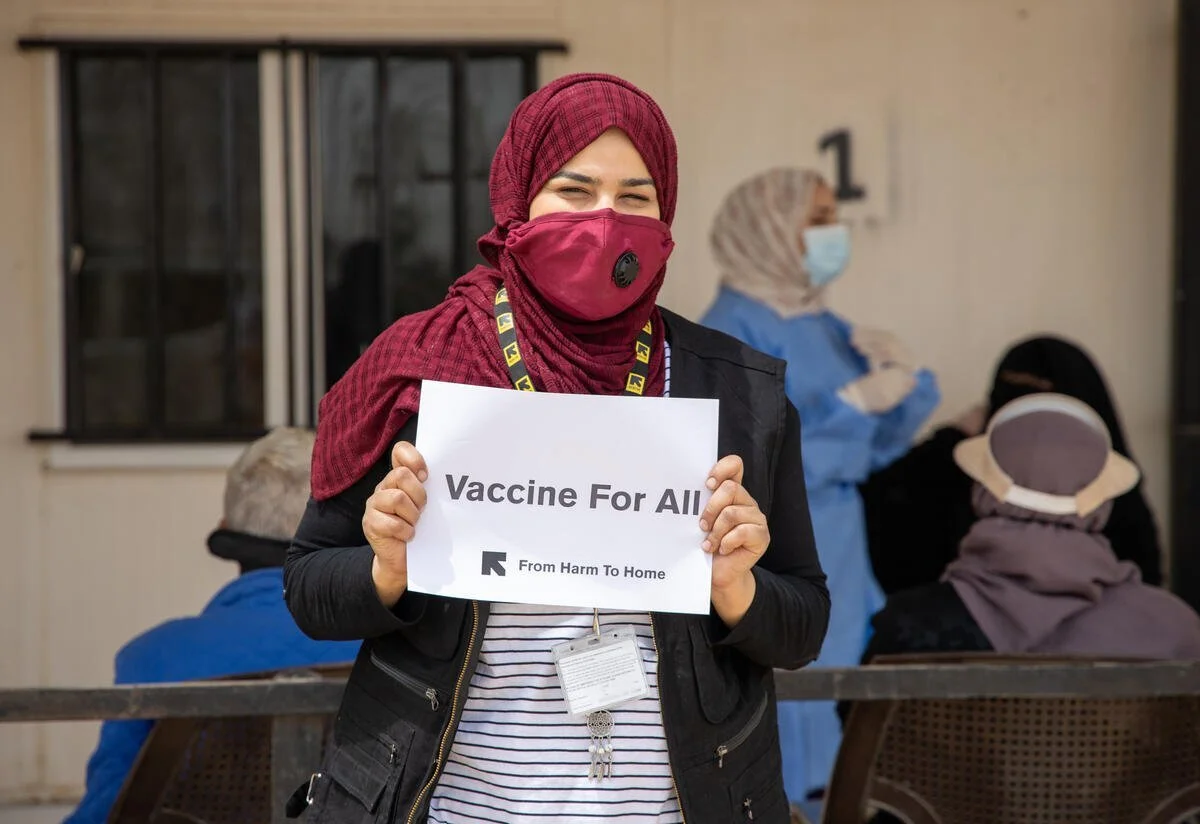THE DISPARITY IN VACCINE AVAILABILITY IS A THREAT TO THE REFUGEE COMMUNITY, AS WELL AS THE REST OF THE WORLD.
By Katherine Leonard, TWR Fellow ‘20
Equitable vaccine distribution is imperative to ending the global pandemic, but this achievement is hindered by the disparity between vaccine access in high-income countries as compared to low- and middle-income countries. The lack of available vaccines in these countries, referred to as LMICs by the UNHCR, poses a risk to the most vulnerable populations, specifically among refugees and asylum seekers.
About 85 percent of refugees are spread throughout the world live in LMICs where they are settled mostly within camps or informal settlements. Their living conditions pose an increased risk of community spread due to a high concentration of individuals in small spaces. For example, the Moira camp in Greece hosts over 18,000 people in a space meant for 2,000 individuals. Since refugee camps also routinely lack necessary healthcare facilities and equipment, it is essential to ensure equitable vaccine distributions to refugee populations. Under the current rates of vaccinations and different countries’ rollout plans, however, refugees tend to be excluded. LMICs already have meager vaccination rates, and few countries have begun vaccinating refugees at the same rate as citizens.
The unequal vaccine distribution largely stems from the inability of low- and middle-income countries to attain vaccines. Right now, high-income countries have enough vaccine doses to inoculate more than double their adult populations. At the same time, low- and middle-income countries do not have enough doses to cover beyond one-third of their populations. In high‑income countries alone, 1 in 4 people have been vaccinated, a ratio that drops precipitously to 1 in 500 in poorer countries.
Vaccines are more accessible to wealthier economies due to the constraints of intellectual property (IP) rights. There are intellectual property protections in place to secure vaccine formulations for vaccines and medical supplies from being manufactured without the consent of the manufacturer holding the rights. The purpose of IP rights is to promote innovation and protect products from unauthorized recreation.
Historically, IP rights have mainly been held by developed countries. This means that the debate over whether these protections should exist has primarily been between developed countries who try to maintain IP rights and developing countries trying to eliminate them. During the peak of the HIV/AIDS crisis nearly two decades ago, many countries did not have the funds to purchase expensive HIV/AIDS drugs patented by pharmaceutical companies in developed countries. After years of dispute, World Trade Organization members in 2003 enacted a waiver that enabled LMICs to import less expensive generic drugs from countries where those drugs are secured by patent.
The COVID-19 pandemic is the most recent international crisis that has revived the debate. Some countries, specifically India and South Africa, are pushing for waivers to be set forth once again. The WTO reviewed the countries’ proposal during a meeting in March, but most rich Western countries, including the UK, US, EU, and Australia, opposed the waiver.
Although an approval of a waiver like the one proposed by India and South Africa would be a significant achievement, there are still several obstacles countries must overcome to bolster vaccinations among refugee populations. Refugees often distrust or fear the government they live under due to a combination of their past experiences of persecution and precarious legal status. At the same time, the information they receive from the government can be sparse due to limited access to technology, an essential tool for information on the vaccine and appointment registrations.
As of right now, about 20 countries are reported to have begun administering vaccines to refugees at equal rates to citizens. One of these countries, Jordan, has guaranteed free vaccinations to anyone in the country, including refugees. Although not every country has been able to execute vaccine administrations yet, 153 states have adopted vaccination strategies that include refugees. The consideration of refugees in these rollout plans reflects the goal of many countries to vaccinate their refugee population, but this goal cannot be realized without coordination on a more widespread level.
Some solutions could be the creation of emergency vaccine sites in LMICs with high refugee populations, the training of refugees to administer vaccines, and extra funding to governments who have pledged to include refugees in their rollout plans. These solutions, however, rely on the widespread availability of vaccines. This cannot be achieved without a reconsideration of the intellectual property rights that allow high-income countries to hoard vaccines and medical supplies while depriving less-advantaged countries of the same essential resources.
Wealthier countries have a major upper hand in the fight against the pandemic. COVID-19 will continue to spread if the world is not equally equipped against it, and the people who will suffer the most are those that are excluded from methods of protection. Refugees, who have already experienced too many hardships in their lifetime, should not be forced to endure any more suffering - especially when it can be avoided through international recognition of the human right to good health.
Banner Image Source: https://www.rescue.org/article/only-way-stop-covid-19-vaccines-all
References:
https://www.kff.org/policy-watch/global-covid-19-vaccine-access-snapshot-of-inequality/

